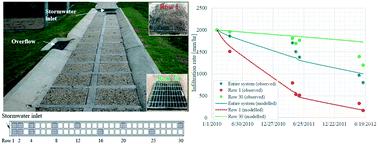当前位置:
X-MOL 学术
›
Environ. Sci.: Water Res. Technol.
›
论文详情
Our official English website, www.x-mol.net, welcomes your
feedback! (Note: you will need to create a separate account there.)
Modelling the clogging of a field filtration system used for stormwater harvesting
Environmental Science: Water Research & Technology ( IF 3.5 ) Pub Date : 2020-01-31 , DOI: 10.1039/c9ew00926d Harpreet Kandra 1, 2, 3, 4 , David T. McCarthy 4, 5, 6, 7, 8 , Ana Deletic 4, 9, 10, 11 , Kefeng Zhang 4, 9, 10, 11
Environmental Science: Water Research & Technology ( IF 3.5 ) Pub Date : 2020-01-31 , DOI: 10.1039/c9ew00926d Harpreet Kandra 1, 2, 3, 4 , David T. McCarthy 4, 5, 6, 7, 8 , Ana Deletic 4, 9, 10, 11 , Kefeng Zhang 4, 9, 10, 11
Affiliation

|
Non-vegetated high-flow stormwater filters have had widespread implementation in urban areas for stormwater management due to their small footprints. Relevant studies on investigation and modelling of the clogging of these systems, however, are quite limited, especially where they are based on real field observations. In this study, the infiltration rates (IR) of a field stormwater harvesting system, consisting of individual high-flow modules for water filtration, were monitored over a 2.5-year time period. A simple conceptual model, comprising a rainfall runoff model and a water balance model (that includes a water distribution model and a linear/exponential regression model), was developed to simulate the evolution of the IR of each filter module. The field observations show that the IR of the entire system dropped from 2000 mm h−1 to an average of 711 mm h−1 after 2.5 years of operation, with the filters closer to the inlet having the lowest IR at the end of testing (i.e., only 167 mm h−1). The models were calibrated highly satisfactorily against a different number of field observation events, with an average Nash–Sutcliffe coefficient (E) value of 0.64 and mean absolute error (MAE) value of 11.8. The validation results show that the linear regression model had better performance, with E mostly being positive (0.03–0.60) and MAE values (15.0–18.9) smaller than the exponential regression model (E < 0 in many cases, and MAE = 14.5–20.7). Compared to the results of previous laboratory experiments, data from this study indicate a slower decline rate of IR in field conditions, showing the importance of natural wetting/drying regimes for the longevity of such filters. The model could be very useful for optimisation of the design and long-term maintenance (e.g., replacement of clogged filter modular components) of modular filtration systems.
中文翻译:

模拟用于雨水收集的现场过滤系统的堵塞
非植物型高流量雨水过滤器由于占地面积小,已在市区广泛用于雨水管理。但是,有关调查和建模这些系统堵塞的相关研究非常有限,尤其是在基于实地观测的情况下。在这项研究中,在2.5年的时间内对由单个用于过滤水的高流量模块组成的田间雨水收集系统的渗透率(IR)进行了监测。开发了一个简单的概念模型,包括降雨径流模型和水平衡模型(包括水分配模型和线性/指数回归模型),以模拟每个过滤器模块的IR演变。现场观察表明,整个系统的IR从2000 mm h开始下降在运行2 .5年后, -1到平均711 mmh -1,在测试结束时,靠近入口的过滤器的IR最低(即只有167 mmh -1)。这些模型针对不同数量的现场观察事件进行了高度满意的校准,平均纳什-萨克利夫系数( E)值为0.64,平均绝对误差(MAE)值为11.8。验证结果表明,线性回归模型具有更好的性能,其中E大多为正值(0.03-0.60),MAE值(15.0-18.9)小于指数回归模型( E在许多情况下,<0,MAE = 14.5–20.7)。与以前的实验室实验结果相比,本研究的数据表明,在田间条件下红外的下降速度较慢,这表明自然润湿/干燥方式对于此类过滤器的使用寿命至关重要。该模型对于优化模块化过滤系统的设计和长期维护(例如,更换堵塞的过滤器模块化组件)可能非常有用。
更新日期:2020-01-31
中文翻译:

模拟用于雨水收集的现场过滤系统的堵塞
非植物型高流量雨水过滤器由于占地面积小,已在市区广泛用于雨水管理。但是,有关调查和建模这些系统堵塞的相关研究非常有限,尤其是在基于实地观测的情况下。在这项研究中,在2.5年的时间内对由单个用于过滤水的高流量模块组成的田间雨水收集系统的渗透率(IR)进行了监测。开发了一个简单的概念模型,包括降雨径流模型和水平衡模型(包括水分配模型和线性/指数回归模型),以模拟每个过滤器模块的IR演变。现场观察表明,整个系统的IR从2000 mm h开始下降在运行2 .5年后, -1到平均711 mmh -1,在测试结束时,靠近入口的过滤器的IR最低(即只有167 mmh -1)。这些模型针对不同数量的现场观察事件进行了高度满意的校准,平均纳什-萨克利夫系数( E)值为0.64,平均绝对误差(MAE)值为11.8。验证结果表明,线性回归模型具有更好的性能,其中E大多为正值(0.03-0.60),MAE值(15.0-18.9)小于指数回归模型( E在许多情况下,<0,MAE = 14.5–20.7)。与以前的实验室实验结果相比,本研究的数据表明,在田间条件下红外的下降速度较慢,这表明自然润湿/干燥方式对于此类过滤器的使用寿命至关重要。该模型对于优化模块化过滤系统的设计和长期维护(例如,更换堵塞的过滤器模块化组件)可能非常有用。











































 京公网安备 11010802027423号
京公网安备 11010802027423号